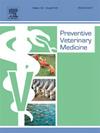Integrating systematic review, meta-analysis, and secondary data for spatial and temporal risk analysis of avian influenza in poultry: A comparative evaluation of OLS, GWR, and MGWR models
IF 2.4
2区 农林科学
Q1 VETERINARY SCIENCES
引用次数: 0
Abstract
Avian influenza (AI) is a highly contagious disease that causes significant mortality and economic losses in the poultry industry. This study integrates meta-analysis with spatial analysis, specifically Ordinary Least Squares (OLS), Geographically Weighted Regression (GWR), and Multiscale Geographically Weighted Regression (MGWR), to identify high-risk areas for AI in Thailand. The independent variables were selected through a systematic meta-analysis, with data sourced from secondary empirical datasets. The dependent variable was based on previous HPAI outbreak data in Thailand. The findings indicate that the central and lower northern regions of Thailand are high-risk areas, strongly linked to rice paddy fields and elevated poultry density. Model comparisons demonstrate that MGWR, utilizing the neighbor-based approach, outperforms both OLS and GWR, achieving higher predictive accuracy (adjusted R² = 0.96, AUC = 0.89, 95 % CI = 0.87–0.91). MGWR’s ability to assign variable-specific spatial scales enhances its capacity to capture spatial heterogeneity. The integration of these methodologies enhances predictive modeling accuracy, allowing authorities to design more efficient surveillance systems and implement focused prevention strategies to reduce the public health risks of avian influenza.
整合系统评价、荟萃分析和次要数据用于家禽禽流感时空风险分析:OLS、GWR和MGWR模型的比较评价
禽流感是一种高度传染性疾病,在家禽业造成重大死亡和经济损失。本研究将元分析与空间分析相结合,特别是普通最小二乘法(OLS)、地理加权回归(GWR)和多尺度地理加权回归(MGWR),以确定泰国人工智能的高风险地区。通过系统的荟萃分析选择自变量,数据来自二手经验数据集。因变量基于泰国以前的高致病性禽流感暴发数据。研究结果表明,泰国中部和北部较低地区是高风险地区,与稻田和家禽密度升高密切相关。模型比较表明,使用基于邻居的方法的MGWR优于OLS和GWR,实现了更高的预测精度(调整后的R²= 0.96,AUC = 0.89, 95 % CI = 0.87-0.91)。MGWR分配特定变量空间尺度的能力增强了其捕捉空间异质性的能力。这些方法的整合提高了预测模型的准确性,使当局能够设计更有效的监测系统并实施重点预防战略,以减少禽流感的公共卫生风险。
本文章由计算机程序翻译,如有差异,请以英文原文为准。
求助全文
约1分钟内获得全文
求助全文
来源期刊

Preventive veterinary medicine
农林科学-兽医学
CiteScore
5.60
自引率
7.70%
发文量
184
审稿时长
3 months
期刊介绍:
Preventive Veterinary Medicine is one of the leading international resources for scientific reports on animal health programs and preventive veterinary medicine. The journal follows the guidelines for standardizing and strengthening the reporting of biomedical research which are available from the CONSORT, MOOSE, PRISMA, REFLECT, STARD, and STROBE statements. The journal focuses on:
Epidemiology of health events relevant to domestic and wild animals;
Economic impacts of epidemic and endemic animal and zoonotic diseases;
Latest methods and approaches in veterinary epidemiology;
Disease and infection control or eradication measures;
The "One Health" concept and the relationships between veterinary medicine, human health, animal-production systems, and the environment;
Development of new techniques in surveillance systems and diagnosis;
Evaluation and control of diseases in animal populations.
 求助内容:
求助内容: 应助结果提醒方式:
应助结果提醒方式:


